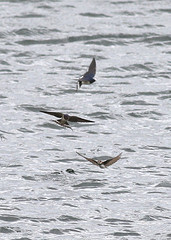Reserve Sightings – April
April is traditionally the month of comings and goings on the reserve, with the arrival of Spring and its usually milder weather assisting our breeding species on their journey back here and giving our over-wintering species that final push back north. The process this year, however, doesn’t seem to be in full motion as of yet. The majority of our over-wintering species are still present on the reserve, albeit in smaller numbers, resulting in the opportunity to see Ospreys fishing next to Pink Footed Geese or Sand Martins gliding through the air and catching insects above Pintail ducks.

In terms of summer migrants, Sand Martin and Osprey sightings have been a near daily occurrence since their arrivals on the 5th and 7th consecutively. Although the Sand Martins arrived quite late this year we would still be expecting their numbers to have risen higher than the maximum count of 8 made so far this month. Most days, around 4 or 5 individuals are being counted, although none have settled in the nesting wall as of yet. The first Swallow sighting on the reserve was made on the 13th, with 2 individuals seen over the Maryton Bay area, with the first sighting at the Visitor Centre being made today (23rd).
With the tern raft now being fully prepared for the season we are eagerly awaiting the arrival of the Common Terns. Although we should be expecting the first sighting any time from the end of April into the first week of May, it’s unlikely that they will return in large numbers or settle on the raft until at least the middle of May. Sandwich Terns are usually the first of the three main Tern species (Common, Sandwich and Arctic) to arrive and can usually be seen from mid April, however they don’t tend to nest on rafts. We’re still a long way off our first expected Arctic Tern sightings, with these occurring as late as June depending on the weather. Arctic Terns will nest on rafts if giving the opportunity, but are beaten to the prize by our earlier arriving Common Terns!
In addition to these summer migrants we still have quite high numbers of our over-wintering species present on the reserve. There are around 1000 Pink Footed Geese that can still be seen roosting on the mud during low tide, along with high numbers of waders such as Redshank, Oystercatcher and Curlew, most of which should be heading inland to their breeding grounds. A small group of Pintails can still be seen every day from the Visitor Centre, the last remnants of the group of over 100 that over-wintered on the reserve.
Other migrant sightings on the reserve have included 2 Ruff and 1 Whimbrel seen on the 13th of this month at the Wigeon Hide, a Common Sandpiper on the 16th and a Marsh Harrier on the 23rd of March. The pair of Water Rails seen in the salt pans, have continued to be seen on a regular basis over the last few weeks. Other sightings have included Blackcaps seen on the 15th, 20th and 21st, 2 Bullfinches seen on the 11th and a Wheatear seen sitting on the salt pans fence on the 10th.
Craig Shepherd,
Visitor Centre Assistant Manager.
Help protect Scotland’s wildlife
Our work to save Scotland’s wildlife is made possible thanks to the generosity of our members and supporters.
Join today from just £3 a month to help protect the species you love.
Preface
April is traditionally the month of comings and goings on the reserve, with the arrival of Spring and its usually milder weather assisting our breeding species on their journey back …
